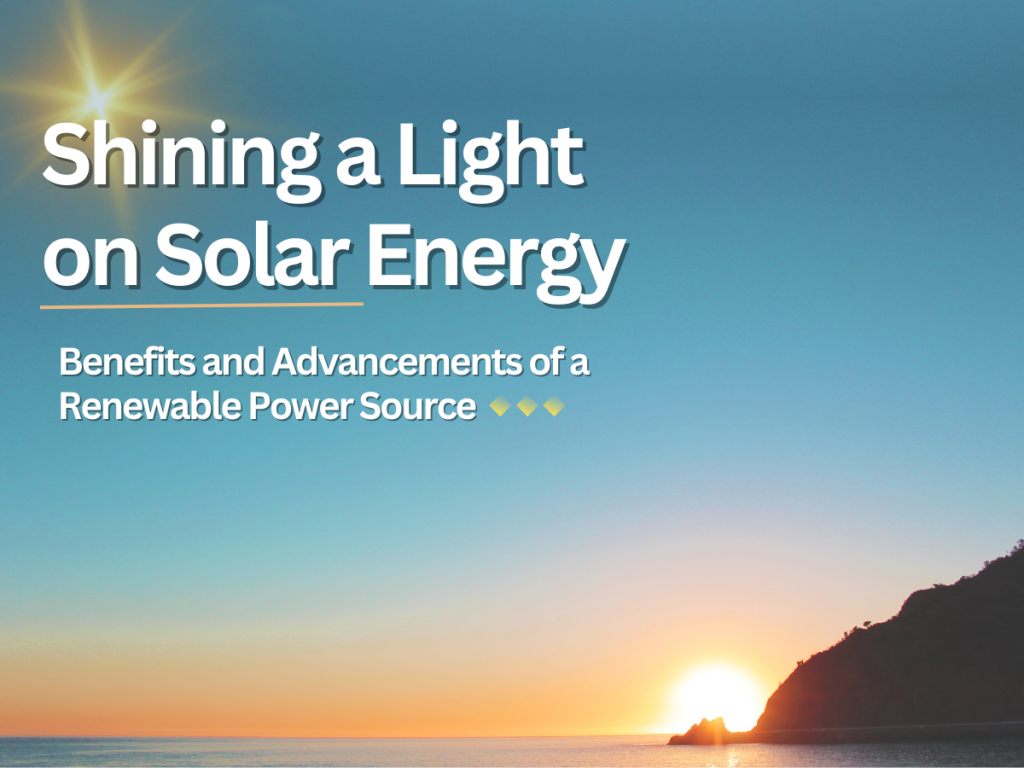
Solar energy is a renewable source of energy generated from the sun’s radiation. It is converted into usable electricity for homes and businesses through solar panels. As a clean and emissions-free source of energy, solar energy can significantly reduce carbon dioxide emissions and combat climate change.

Benefits of using solar energy
- Renewable and sustainable – solar energy is an unlimited resource and does not emit greenhouse gasses.
- Reduces energy costs – once installed, solar energy systems can greatly reduce or eliminate electricity bills.
- Increases energy independence – solar energy systems can provide power even when the grid is down.
- Reduces carbon footprint – solar energy is a clean, emissions-free source of energy.
- Creates jobs – the solar energy industry is growing and providing job opportunities in manufacturing, installation, and maintenance.
- Diversifies energy sources – using solar energy helps to reduce reliance on fossil fuels and decrease vulnerability to price fluctuations.
- Improves public health – solar energy systems do not produce harmful pollutants that can affect air and water quality.

How is solar energy converted into different forms of energy?
Solar energy can be converted into different forms of energy such as:
- Electricity – using photovoltaic cells in solar panels to convert light into direct current (DC) electricity, which is then converted into alternating current (AC) for use in homes and businesses.
- Thermal Energy – using solar thermal collectors to capture the sun’s heat and use it for water heating or space heating.
- Chemical Energy – using the sun’s energy to produce hydrogen fuel through a process called water electrolysis.
- Mechanical Energy – using the sun’s heat to power engines or turbines.
- Bioenergy – using the sun’s energy to grow crops for fuel or food, which can then be converted into biofuels such as ethanol or biodiesel.

Solar Technologies
Solar photovoltaic (PV) panels – converts sunlight directly into electricity. Concentrated solar power (CSP) – uses mirrors or lenses to concentrate sunlight onto a small area, which then heats a fluid to generate electricity. Solar water heating systems – uses sunlight to heat water for domestic or industrial use. Solar air heating systems – uses sunlight to heat air, which is then used for space heating or drying. Solar cookers – uses sunlight to cook food without the need for fuel. Building-integrated photovoltaics (BIPV) – integrates solar panels into the design of buildings to generate electricity and provide shading. Solar-powered vehicles – uses solar energy to power electric vehicles. Floating solar arrays – solar panels installed on water bodies such as reservoirs or ponds.

Solar Market Today in USA
The solar market in the USA has grown significantly in recent years. According to the Solar Energy Industries Association (SEIA), the US installed a record 19.2 GW of solar capacity in 2020, which is enough to power over 3.6 million homes. The residential sector saw a 11% increase in installations compared to 2019, while the non-residential and utility-scale sectors also saw significant growth. California remained the top state for solar installations, followed by Texas, Florida, and North Carolina. The SEIA predicts continued growth in the solar market in the coming years, driven by falling costs, favorable policies, and increased demand from consumers and businesses.
As a whole, the solar market has grown by 33% per year in the United States over the last decade. U.S. solar installations total more than 3.8 million, ranging from home rooftop systems to large utility-scale installations producing hundreds of megawatts of clean electricity.

Uses of Solar Energy
- Generating electricity for homes and businesses
- Powering satellites and remote off-grid locations
- Heating water for homes and industrial processes
- Producing steam for electricity generation in power plants
- Drying crops and powering irrigation systems
- Charging batteries in vehicles and electronic devices.

